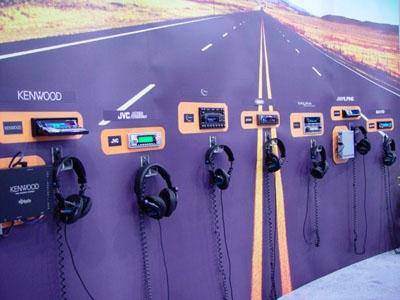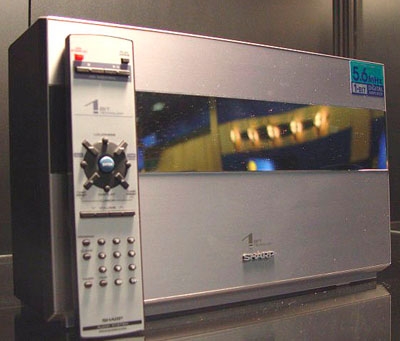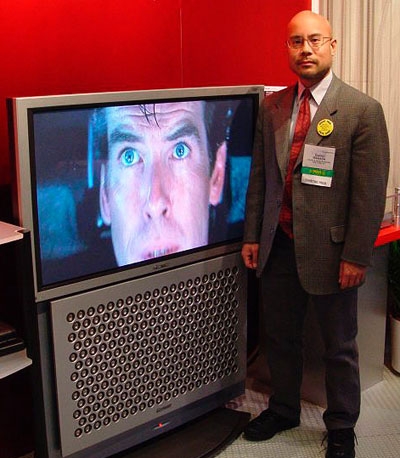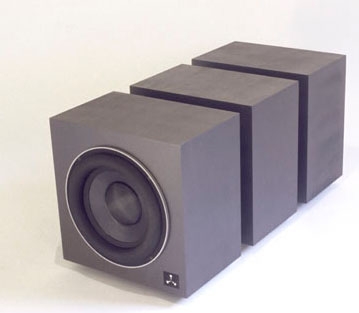Digital Audio's Last Frontiers

This CES saw the official introduction of what used to be called the IBOC (in-Band, on-channel) terrestrial digital radio system, freshly renamed HD Radio (for high-definition) by its promotor, iBiquity. Decoding for iBiquity's version of the system (the only one we're going to get) was built into car receivers from most of the major players as well as home receivers from Kenwood, Harman Kardon, and Yamaha. The system uses the same audio codec as Sirius satellite radio, but the data rate is considerably higher (96 kilobits per second). Hopefully this will lead to substantially superior sound quality, at least in theory. The commercial pressures that force FM stations to sound as they do will still apply to HD Radio and will probably lead to a static-free but still overcompressed sound quality. We'll be testing this for a future issue of Sound & Vision. iBiquity invited showgoers to sample the sound of the new HD Radio on car head units equipped to receive the digital broadcasts. Single-bit technology is spreading, albeit slowly, into other places besides Super Audio CD players and digital-to-analog converters. Both Harman Kardon and Sharp had all-digital receivers at CES, for example, like the Sharp SD-EX111 home entertainment center shown here. Fortunately, instead of claiming superior audio quality for 1-bit devices, which would be difficult to prove because conventional technology is so good, the manufacturers are tending to focus on 1-bit's real advantages: letting them build considerably smaller and lighter (and, ultimately, less expensive) components that can still deliver large amounts of power.  Sharp's compact all-digital SD-EX111 home-entertainment center, combining a receiver and CD player, uses 1-bit technology to save on size and weight. The two most striking products I saw at the show were in that most traditional of audio categories-speakers-but they were very heavily indebted to digital signal processing (DSP) to work at all, let alone well. The real showstopper (I had to wrestle my way past several camera crews to hear it) was Pioneer's PDSP-1 Digital Sound Projector, a $40,000 array of 254 1-inch long-throw drivers. What's fascinating about this device, aside from the price, is its principle of operation. Like an advanced military sonar, the big flat-panel radars of AEGIS-equipped U.S. Navy ships (like Ticonderoga-class cruisers), or the ballistic-missile warning system, Pioneer's new speaker operates on the principle of the phased array (this is not one of those "ultrasonic" flat-panel speakers you may have heard about). The small speakers are driven by individual digital amplifiers, but their outputs are phased in such a way that they interfere with each other in a controlled fashion to create multiple separate sound "beams" (a process called "beamforming")-in this case, a separate beam for each channel of a five-channel surround sound system. When the panel is placed and adjusted correctly, the beams reflect off the walls and the ceiling, and the listener hears a virtual speaker at each point of reflection. As demonstrated by Pioneer, the PDSP-1 was in the front of the room, beneath a large flat-panel video display, and yet I heard convincing, firmly placed left/right speakers off to the sides in the front, a well-centered speaker in the middle, and phantom surround speakers high on each side of the room.
Sharp's compact all-digital SD-EX111 home-entertainment center, combining a receiver and CD player, uses 1-bit technology to save on size and weight. The two most striking products I saw at the show were in that most traditional of audio categories-speakers-but they were very heavily indebted to digital signal processing (DSP) to work at all, let alone well. The real showstopper (I had to wrestle my way past several camera crews to hear it) was Pioneer's PDSP-1 Digital Sound Projector, a $40,000 array of 254 1-inch long-throw drivers. What's fascinating about this device, aside from the price, is its principle of operation. Like an advanced military sonar, the big flat-panel radars of AEGIS-equipped U.S. Navy ships (like Ticonderoga-class cruisers), or the ballistic-missile warning system, Pioneer's new speaker operates on the principle of the phased array (this is not one of those "ultrasonic" flat-panel speakers you may have heard about). The small speakers are driven by individual digital amplifiers, but their outputs are phased in such a way that they interfere with each other in a controlled fashion to create multiple separate sound "beams" (a process called "beamforming")-in this case, a separate beam for each channel of a five-channel surround sound system. When the panel is placed and adjusted correctly, the beams reflect off the walls and the ceiling, and the listener hears a virtual speaker at each point of reflection. As demonstrated by Pioneer, the PDSP-1 was in the front of the room, beneath a large flat-panel video display, and yet I heard convincing, firmly placed left/right speakers off to the sides in the front, a well-centered speaker in the middle, and phantom surround speakers high on each side of the room.  David Ranada stands next to a plasma TV sitting atop Pioneer's PDSP-1 Digital Sound Projector. The panel of 254 tiny, individually amplified speakers uses extensive digital signal processing to simulate a five-channel surround sound speaker system. It costs $40,000 now, but the price will fall if the idea catches on. One of the reasons the system is so expensive is the amount of digital signal processing it has to do, particularly since the number of beams is adjustable, as is their direction and where their "focus" points fall (somewhere before the beam hits a wall or ceiling), as well as such conventional audio processing as equalization. Besides, 254 drivers powered by 254 digital power amps can't be cheap. But the system has great potential both for simplification and for a vast reduction in cost with mass production. A phased array like Pioneer's can't generate high levels of deep bass, and in the demonstration it was supplemented by conventional subwoofers crossing over at 120 Hz. It might make a good match with the other DSP-boosted speaker I found at the show, the $11,700 IA-643 subwoofer, the first product from Intelligent Audio Systems of Berkeley, California. The two end boxes of the three connected enclosures each contain a 12-inch driver with a massive magnet assembly (I tried lifting one), while the central box contains four 500-watt Class-D digital amplifiers as well as the digital processing that controls the signals sent to each driver.
David Ranada stands next to a plasma TV sitting atop Pioneer's PDSP-1 Digital Sound Projector. The panel of 254 tiny, individually amplified speakers uses extensive digital signal processing to simulate a five-channel surround sound speaker system. It costs $40,000 now, but the price will fall if the idea catches on. One of the reasons the system is so expensive is the amount of digital signal processing it has to do, particularly since the number of beams is adjustable, as is their direction and where their "focus" points fall (somewhere before the beam hits a wall or ceiling), as well as such conventional audio processing as equalization. Besides, 254 drivers powered by 254 digital power amps can't be cheap. But the system has great potential both for simplification and for a vast reduction in cost with mass production. A phased array like Pioneer's can't generate high levels of deep bass, and in the demonstration it was supplemented by conventional subwoofers crossing over at 120 Hz. It might make a good match with the other DSP-boosted speaker I found at the show, the $11,700 IA-643 subwoofer, the first product from Intelligent Audio Systems of Berkeley, California. The two end boxes of the three connected enclosures each contain a 12-inch driver with a massive magnet assembly (I tried lifting one), while the central box contains four 500-watt Class-D digital amplifiers as well as the digital processing that controls the signals sent to each driver.  The IA-643 subwoofer from Intelligent Audio Systems ($11,700) uses digital signal processing to continuously vary the relative phase of its two 12-inch drivers according to frequency. This adjusts the speaker's output both to the room characteristics and to the characteristics of the main speakers in the system. What makes this more than just another big subwoofer is that the relative phasing of the two drivers can be continuously varied from monopole (in-phase) to dipole (out-of-phase) operation depending on the frequency. They can, for example, be in phase at 30 Hz but slightly out of phase at 75 Hz. The effect is to change the directivity or dispersion of the speaker according to frequency. If this is done correctly, the result at the listening position can be a much smoother bass response, unaffected by room acoustical anomalies such as standing waves. This is a totally different approach to the sonic holy grail of a "room-corrected" speaker than has been taken by other digitally processed systems (the details get real complex, real quick). Of course, doing this "correctly" requires not only a computer to figure out how the drivers are supposed to be driven, but some way to measure the room/speaker system. To that end, the manufacturer supplies a Bluetooth-enabled remote control with built-in microphone that will enable a setup to be completed, without the assistance of a professional installer, in less than a minute. Demonstrations at the IAS booth with both classic Quad electrostatic speakers as well as a set of $100 satellites from NHT showed the IA-643 to be quite versatile in matching the characteristics of the main speakers in a system. In both cases there was a seamless transition from the bass to the midrange, something that's difficult to obtain even with professional assistance when using conventional subwoofers. Like the Pioneer phased array, the IA-643 (which could be considered a very stripped-down, two-driver phased array) has great potential for cost reduction when mass produced. I'm looking forward to hearing the results when this happens. (Photos by David Ranada)
The IA-643 subwoofer from Intelligent Audio Systems ($11,700) uses digital signal processing to continuously vary the relative phase of its two 12-inch drivers according to frequency. This adjusts the speaker's output both to the room characteristics and to the characteristics of the main speakers in the system. What makes this more than just another big subwoofer is that the relative phasing of the two drivers can be continuously varied from monopole (in-phase) to dipole (out-of-phase) operation depending on the frequency. They can, for example, be in phase at 30 Hz but slightly out of phase at 75 Hz. The effect is to change the directivity or dispersion of the speaker according to frequency. If this is done correctly, the result at the listening position can be a much smoother bass response, unaffected by room acoustical anomalies such as standing waves. This is a totally different approach to the sonic holy grail of a "room-corrected" speaker than has been taken by other digitally processed systems (the details get real complex, real quick). Of course, doing this "correctly" requires not only a computer to figure out how the drivers are supposed to be driven, but some way to measure the room/speaker system. To that end, the manufacturer supplies a Bluetooth-enabled remote control with built-in microphone that will enable a setup to be completed, without the assistance of a professional installer, in less than a minute. Demonstrations at the IAS booth with both classic Quad electrostatic speakers as well as a set of $100 satellites from NHT showed the IA-643 to be quite versatile in matching the characteristics of the main speakers in a system. In both cases there was a seamless transition from the bass to the midrange, something that's difficult to obtain even with professional assistance when using conventional subwoofers. Like the Pioneer phased array, the IA-643 (which could be considered a very stripped-down, two-driver phased array) has great potential for cost reduction when mass produced. I'm looking forward to hearing the results when this happens. (Photos by David Ranada)
 Sharp's compact all-digital SD-EX111 home-entertainment center, combining a receiver and CD player, uses 1-bit technology to save on size and weight. The two most striking products I saw at the show were in that most traditional of audio categories-speakers-but they were very heavily indebted to digital signal processing (DSP) to work at all, let alone well. The real showstopper (I had to wrestle my way past several camera crews to hear it) was Pioneer's PDSP-1 Digital Sound Projector, a $40,000 array of 254 1-inch long-throw drivers. What's fascinating about this device, aside from the price, is its principle of operation. Like an advanced military sonar, the big flat-panel radars of AEGIS-equipped U.S. Navy ships (like Ticonderoga-class cruisers), or the ballistic-missile warning system, Pioneer's new speaker operates on the principle of the phased array (this is not one of those "ultrasonic" flat-panel speakers you may have heard about). The small speakers are driven by individual digital amplifiers, but their outputs are phased in such a way that they interfere with each other in a controlled fashion to create multiple separate sound "beams" (a process called "beamforming")-in this case, a separate beam for each channel of a five-channel surround sound system. When the panel is placed and adjusted correctly, the beams reflect off the walls and the ceiling, and the listener hears a virtual speaker at each point of reflection. As demonstrated by Pioneer, the PDSP-1 was in the front of the room, beneath a large flat-panel video display, and yet I heard convincing, firmly placed left/right speakers off to the sides in the front, a well-centered speaker in the middle, and phantom surround speakers high on each side of the room.
Sharp's compact all-digital SD-EX111 home-entertainment center, combining a receiver and CD player, uses 1-bit technology to save on size and weight. The two most striking products I saw at the show were in that most traditional of audio categories-speakers-but they were very heavily indebted to digital signal processing (DSP) to work at all, let alone well. The real showstopper (I had to wrestle my way past several camera crews to hear it) was Pioneer's PDSP-1 Digital Sound Projector, a $40,000 array of 254 1-inch long-throw drivers. What's fascinating about this device, aside from the price, is its principle of operation. Like an advanced military sonar, the big flat-panel radars of AEGIS-equipped U.S. Navy ships (like Ticonderoga-class cruisers), or the ballistic-missile warning system, Pioneer's new speaker operates on the principle of the phased array (this is not one of those "ultrasonic" flat-panel speakers you may have heard about). The small speakers are driven by individual digital amplifiers, but their outputs are phased in such a way that they interfere with each other in a controlled fashion to create multiple separate sound "beams" (a process called "beamforming")-in this case, a separate beam for each channel of a five-channel surround sound system. When the panel is placed and adjusted correctly, the beams reflect off the walls and the ceiling, and the listener hears a virtual speaker at each point of reflection. As demonstrated by Pioneer, the PDSP-1 was in the front of the room, beneath a large flat-panel video display, and yet I heard convincing, firmly placed left/right speakers off to the sides in the front, a well-centered speaker in the middle, and phantom surround speakers high on each side of the room.  David Ranada stands next to a plasma TV sitting atop Pioneer's PDSP-1 Digital Sound Projector. The panel of 254 tiny, individually amplified speakers uses extensive digital signal processing to simulate a five-channel surround sound speaker system. It costs $40,000 now, but the price will fall if the idea catches on. One of the reasons the system is so expensive is the amount of digital signal processing it has to do, particularly since the number of beams is adjustable, as is their direction and where their "focus" points fall (somewhere before the beam hits a wall or ceiling), as well as such conventional audio processing as equalization. Besides, 254 drivers powered by 254 digital power amps can't be cheap. But the system has great potential both for simplification and for a vast reduction in cost with mass production. A phased array like Pioneer's can't generate high levels of deep bass, and in the demonstration it was supplemented by conventional subwoofers crossing over at 120 Hz. It might make a good match with the other DSP-boosted speaker I found at the show, the $11,700 IA-643 subwoofer, the first product from Intelligent Audio Systems of Berkeley, California. The two end boxes of the three connected enclosures each contain a 12-inch driver with a massive magnet assembly (I tried lifting one), while the central box contains four 500-watt Class-D digital amplifiers as well as the digital processing that controls the signals sent to each driver.
David Ranada stands next to a plasma TV sitting atop Pioneer's PDSP-1 Digital Sound Projector. The panel of 254 tiny, individually amplified speakers uses extensive digital signal processing to simulate a five-channel surround sound speaker system. It costs $40,000 now, but the price will fall if the idea catches on. One of the reasons the system is so expensive is the amount of digital signal processing it has to do, particularly since the number of beams is adjustable, as is their direction and where their "focus" points fall (somewhere before the beam hits a wall or ceiling), as well as such conventional audio processing as equalization. Besides, 254 drivers powered by 254 digital power amps can't be cheap. But the system has great potential both for simplification and for a vast reduction in cost with mass production. A phased array like Pioneer's can't generate high levels of deep bass, and in the demonstration it was supplemented by conventional subwoofers crossing over at 120 Hz. It might make a good match with the other DSP-boosted speaker I found at the show, the $11,700 IA-643 subwoofer, the first product from Intelligent Audio Systems of Berkeley, California. The two end boxes of the three connected enclosures each contain a 12-inch driver with a massive magnet assembly (I tried lifting one), while the central box contains four 500-watt Class-D digital amplifiers as well as the digital processing that controls the signals sent to each driver.  The IA-643 subwoofer from Intelligent Audio Systems ($11,700) uses digital signal processing to continuously vary the relative phase of its two 12-inch drivers according to frequency. This adjusts the speaker's output both to the room characteristics and to the characteristics of the main speakers in the system. What makes this more than just another big subwoofer is that the relative phasing of the two drivers can be continuously varied from monopole (in-phase) to dipole (out-of-phase) operation depending on the frequency. They can, for example, be in phase at 30 Hz but slightly out of phase at 75 Hz. The effect is to change the directivity or dispersion of the speaker according to frequency. If this is done correctly, the result at the listening position can be a much smoother bass response, unaffected by room acoustical anomalies such as standing waves. This is a totally different approach to the sonic holy grail of a "room-corrected" speaker than has been taken by other digitally processed systems (the details get real complex, real quick). Of course, doing this "correctly" requires not only a computer to figure out how the drivers are supposed to be driven, but some way to measure the room/speaker system. To that end, the manufacturer supplies a Bluetooth-enabled remote control with built-in microphone that will enable a setup to be completed, without the assistance of a professional installer, in less than a minute. Demonstrations at the IAS booth with both classic Quad electrostatic speakers as well as a set of $100 satellites from NHT showed the IA-643 to be quite versatile in matching the characteristics of the main speakers in a system. In both cases there was a seamless transition from the bass to the midrange, something that's difficult to obtain even with professional assistance when using conventional subwoofers. Like the Pioneer phased array, the IA-643 (which could be considered a very stripped-down, two-driver phased array) has great potential for cost reduction when mass produced. I'm looking forward to hearing the results when this happens. (Photos by David Ranada)
The IA-643 subwoofer from Intelligent Audio Systems ($11,700) uses digital signal processing to continuously vary the relative phase of its two 12-inch drivers according to frequency. This adjusts the speaker's output both to the room characteristics and to the characteristics of the main speakers in the system. What makes this more than just another big subwoofer is that the relative phasing of the two drivers can be continuously varied from monopole (in-phase) to dipole (out-of-phase) operation depending on the frequency. They can, for example, be in phase at 30 Hz but slightly out of phase at 75 Hz. The effect is to change the directivity or dispersion of the speaker according to frequency. If this is done correctly, the result at the listening position can be a much smoother bass response, unaffected by room acoustical anomalies such as standing waves. This is a totally different approach to the sonic holy grail of a "room-corrected" speaker than has been taken by other digitally processed systems (the details get real complex, real quick). Of course, doing this "correctly" requires not only a computer to figure out how the drivers are supposed to be driven, but some way to measure the room/speaker system. To that end, the manufacturer supplies a Bluetooth-enabled remote control with built-in microphone that will enable a setup to be completed, without the assistance of a professional installer, in less than a minute. Demonstrations at the IAS booth with both classic Quad electrostatic speakers as well as a set of $100 satellites from NHT showed the IA-643 to be quite versatile in matching the characteristics of the main speakers in a system. In both cases there was a seamless transition from the bass to the midrange, something that's difficult to obtain even with professional assistance when using conventional subwoofers. Like the Pioneer phased array, the IA-643 (which could be considered a very stripped-down, two-driver phased array) has great potential for cost reduction when mass produced. I'm looking forward to hearing the results when this happens. (Photos by David Ranada)




























































